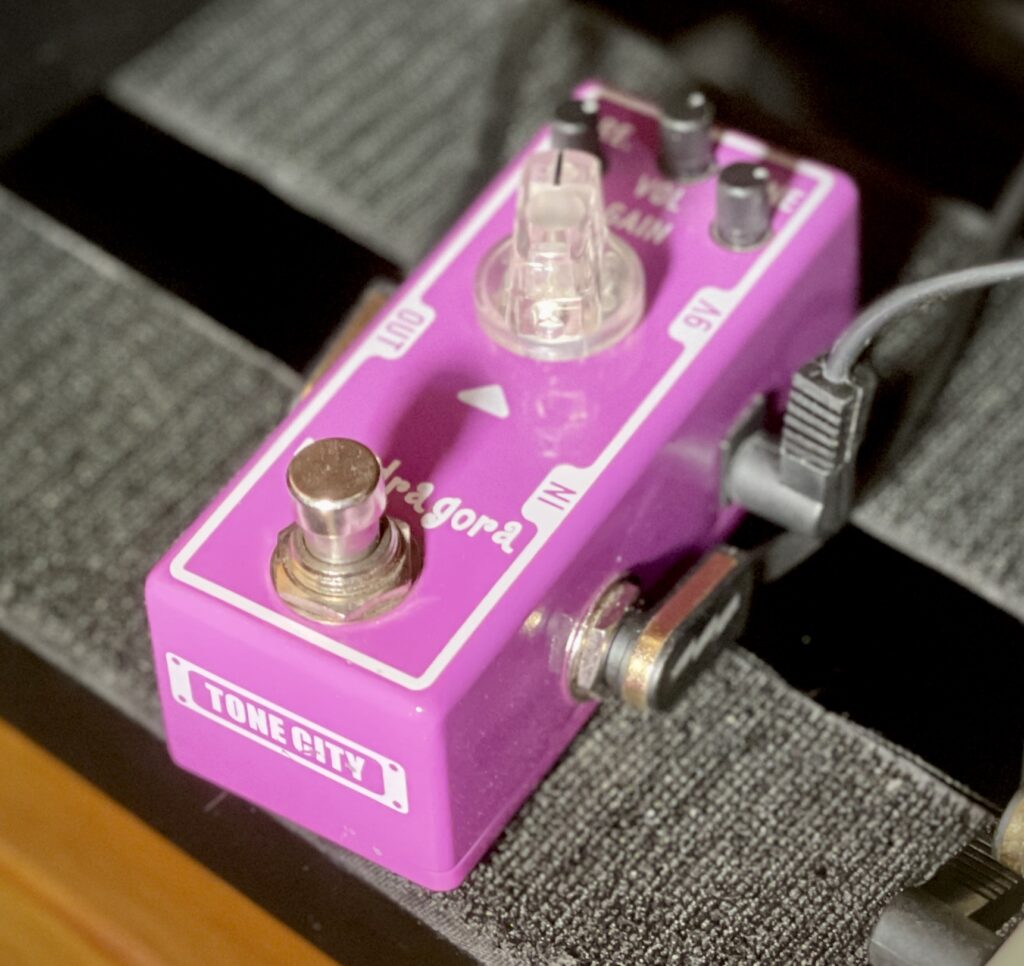I’ve had a lot of fun with the two Tone City pedals that I recently picked up. So when the opportunity arose to pick up another one at a nice price, hell yeah, why not?

What Did You Buy?
I bought a Tone City Mandragora overdrive pedal. I got mine from the second-hand market.
What Is It?
The Mandragora is an overdrive pedal that is based on Lovepedal’s Kalamazoo overdrive pedal. There’s been at least two versions of the Kalamazoo over the years (possibly more). I don’t know which version of the Kalamazoo the Mandragora is based on, or even if the differences matter.
Why Did You Buy It?
I’ve picked up several Tone City pedals recently: Sweet Cream Overdrive, Bad Horse Overdrive, and the Dry Martini Overdrive. Each one has been well made, sounded good, and gave me something that I didn’t have before.
So why not keep an eye out for any more that come up for sale?
These are dirt-cheap pedals if you buy them brand new from a store like Andertons. If you go after any of these on the second-hand market, be patient. It doesn’t take much interest at all to push one of these pedals up to the same price as the ones in the stores.
I managed to snag the Mandragora at a nice price. Let’s see if it was worth it.
What Is Your Signal Chain?
Today, I’m running:
- my Les Paul
- into the Axe-FX 3 (mostly for the digital tuner)
- out to my pedalboard
- back into the Axe-FX 3 (for amp, cabs, delay and reverb)
- out to my audio interface
- into my DAW
On the pedalboard, I have the Tone City Mandragora, Tone City Durple and my Klon KTR. They’re all in separate loops on my Gigrig G2, so that they don’t affect the overall signal when they’re not being used.
All the effects you’re hearing are coming from the Axe-FX 3. There’s absolutely no post-processing being applied in my DAW.
How Does It Sound?
Here’s an audio example:
It’s a perfectly competent, generic / middle-of-the-road overdrive pedal. It fills out the mids nicely, without adding problematic noise at all.
I’d put it firmly in the category of boring-yet-necessary overdrive pedals, myself. It’s not doing anything special. It doesn’t stand out to me in any particular way. If you’re trying to fit into a larger sound / mix, where guitar isn’t a featured instrument, definitely worth exploring.
The one concern I do have with it is that it doesn’t have quite as much note separation as I normally want. That can clearly be heard towards the end of my demo piece, where the featured notes in the chords are very indistinct. Now, the gain is up at around 1 o’clock, and it might be that I just need to back the gain off a bit to solve that.
Be Careful With The Pre Control
The ‘Pre’ control on the pedal is a separate presence control. If it works like the Kalamazoo’s Glass control, it’s separate to the functioning of the tone pot.
Crank it up more than you need to, and it can make this pedal sound harsh and horrible.
I had the best success by starting with it all the way down, and then gradually turning it up to suit the guitar I was using at the time. When switching guitars, I found that I could leave the other knobs largely alone, but I had to adjust the Pre control each time to get the best out of the pedal.
Not a criticism: I think it’s awesome when a pedal gives us the tools to make it work well with different guitars.
How Does It Compare To The Tone City Durple?
The Tone City Durple is a signature pedal for Anderton’s Peter Honoré, based on the Mandragora. Where the Mandragora has the Pre control, the Durple has a Mids control instead. There may be other changes to the circuit too?
Here’s how the Durple sounds:
While you can hear the family connection, the Durple brings a lot more low-end to the party. That makes sense, given that Danish Pete is known to be a Telecaster player. All that extra low-end from the Durple probably suits the bridge pickup of a Telecaster.
The other thing that caught my ear: I got a lot more sustain out of the Durple compared to the Mandragora. Maybe the Durple is just a more compressed pedal?
I suspect there’s space for both the Durple and the Mandragora on the same pedal board. Dial in one as your rhythm tone, and the other as your lead tone. Which pedal for which role would depend on your guitar of choice.
How Does It Compare To The Lovepedal Kalamazoo?
I don’t know. I’ve never owned a Lovepedal Kalamazoo, and they were around largely before the golden era of high-quality YouTube demos.
I’m going to keep an eye out for a genuine Kalamazoo to add to my collection, but I don’t expect to find one any time soon. There aren’t many Lovepedal pedals going on the second-hand market these days over here, and I’m not interested in paying a lot for one.
Final Thoughts
This is another winner from Tone City.
I continue to be very pleased with both their build quality and their sonic quality. Every one that I’ve tried works well, has no noise issues, and doesn’t disappoint.
I’m not sure how much I’ll use the Mandragora, to be honest. When I want this kind of overdrive tone, I’m much more likely to reach for my Wampler Belle or Lovepedal Amp 11, simply because both pedals have more powerful EQ stacks.
But if I didn’t have those other pedals, the Mandragora would definitely be one I’d consider for that kind of role.

One Reply to “First Impressions: Tone City Mandragora Overdrive Pedal”